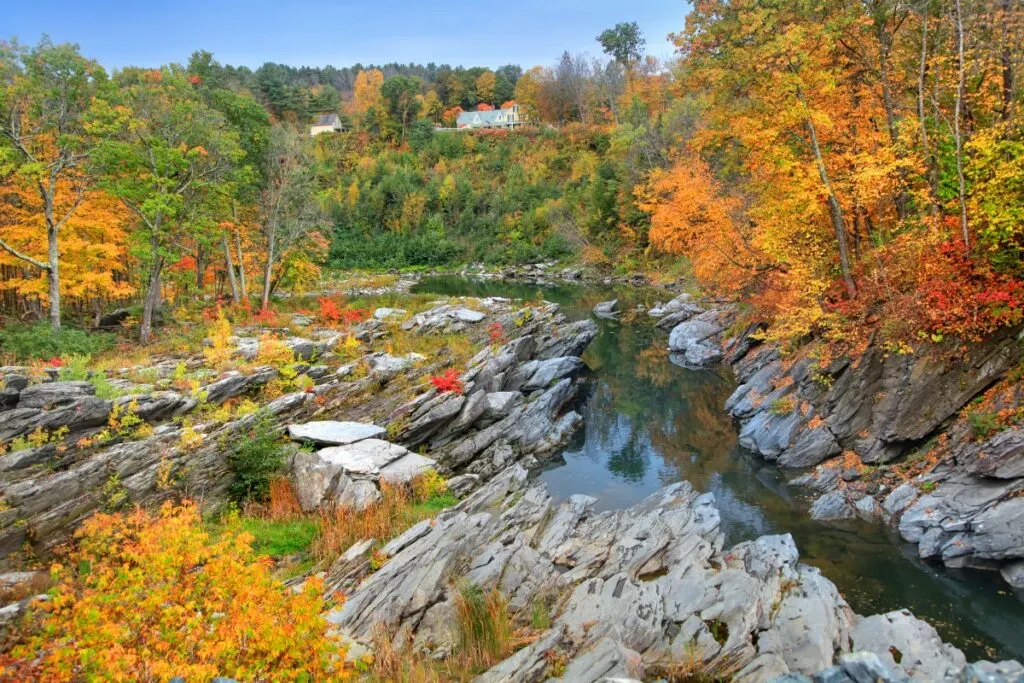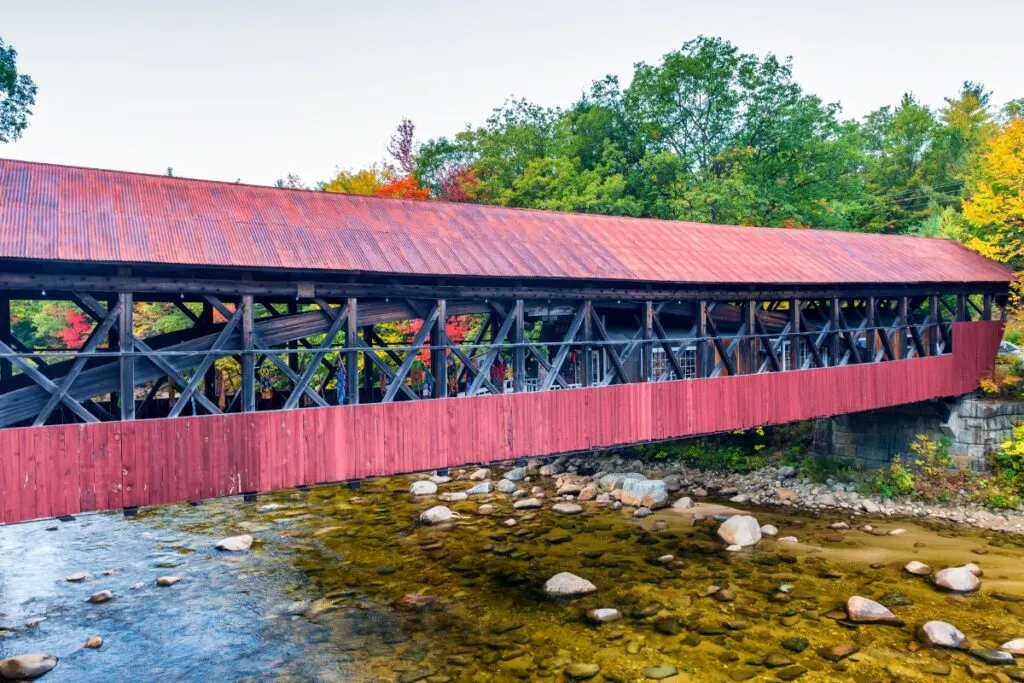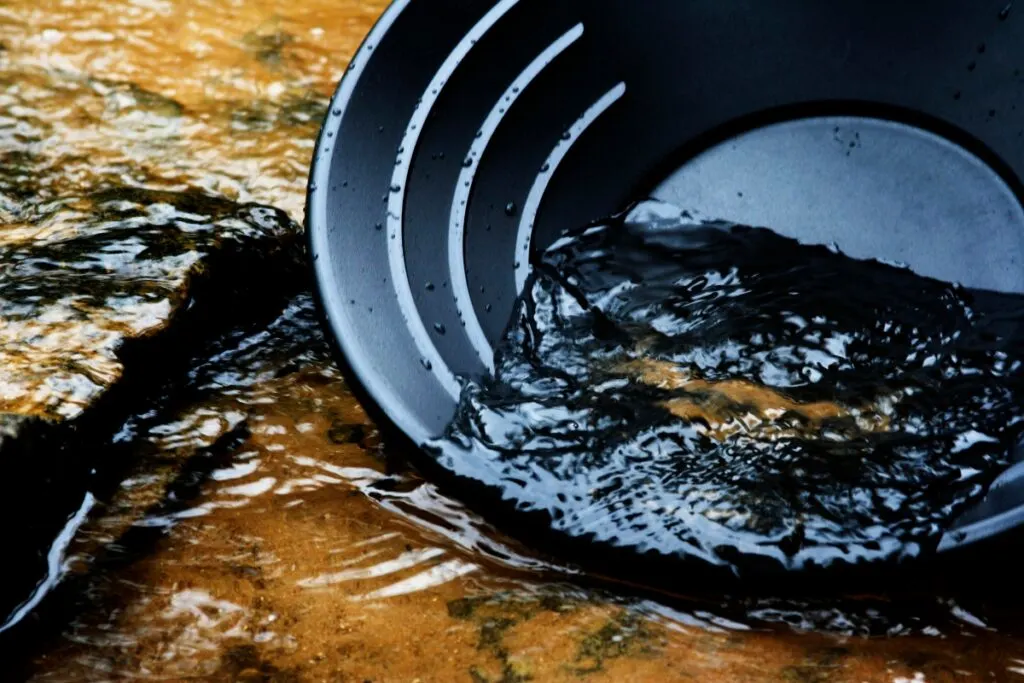As an Amazon Associate, I earn from qualifying purchases with no additional costs for you.
Vermont, renowned for its picturesque rivers, creeks, and mountains, holds a glittering secret dating back to the 19th century – a rich history of gold prospecting.
The best gold prospecting locations in Vermont are:
- Mad River
- Ottauquechee River
- Williams River
- White River
- Broad Brook
- Gold Brook
- Buffalo Brook
We’ll explore gold prospecting in Vermont and uncover the top locations for gold panning and sluicing while delving into the legal aspects you should consider before embarking on your golden adventure. This piece will be your go-to resource for everything you need about striking it rich in Vermont.

If you want to check out the best tools and equipment for gold prospecting, you can find them by clicking here (Amazon link).
The Legality of Gold Prospecting in Vermont
Unlike its western cousins such as California or Alaska, Vermont has a quite fascinating, and to be frank, slightly different approach to gold prospecting laws.
A quick rummage through the State’s mineral laws reveals that Vermont does permit gold prospecting – however, with certain caveats. Private property rights remain sovereign, meaning that prospecting on private land requires explicit permission from the owner.
Regarding environmental regulations, Green Mountain State is strongly committed to preserving its natural beauty.
Vermont’s Agency of Natural Resources requires that prospectors abide by certain environmental regulations to safeguard the State’s exquisite natural habitats.
For instance, ‘stream alteration permits’ may be required if your prospecting activities disturb the stream bed. And then there’s the question of private property and landowner rights, adding an extra layer to the puzzle.
7 Best Places to Find Gold in Vermont
Vermont offers a wealth of opportunities for gold prospectors. From rivers and creeks to historic mines. The video below is a great example of a great gold prospecting opportunity in Vermont:
Here are the seven best places to find gold in Vermont.
Mad River
The Mad River is located in Warren, VT, and has a history of gold findings. The Mad River is well-known for its icy-blue waters, which are said to carry fine flour gold. Gold panning in Mad River is quite a relaxing pastime. Plus, you can engage in other activities like fishing and canoeing.
As one of Vermont’s most famous gold-bearing rivers, Mad River is a favored spot for novice and experienced prospectors.
Situated in the northern part of the State, it’s known for its consistent yield of placer gold, found particularly around the Warren and Moretown areas.
During the spring melt, gold from the surrounding hillsides washes into the river, making it a veritable treasure trove for prospectors. This river isn’t just famous for its name.
It’s been surprising prospectors for years with its unexpected treasures. Known for its fine gold, don’t let the river’s tranquil nature fool you.
There’s more beneath the surface than meets the eye. The river has a strong current, so be prepared to work harder to hold your spot.
Ottauquechee River
Ottauquechee River, Located in the eastern part of the State, the Ottauquechee River is another notable spot for gold panning. Be sure to check around the town of Bridgewater for the best yields.
The gold here is often very fine; this river offers a scenic view and is known for its placer deposits. Stories have swirled for years about the glittering specks found in its bed.
The river’s course through Quechee State Park also provides a fantastic opportunity for recreational panning.
Gold panning in the Ottauquechee River could be combined with hiking; along with gold, you can also find garnets here, making your treasure hunting doubly rewarding.
TIP: Find out my recommended products if you are looking for the best tools you need to find gold (Amazon link):
- Gold Metal Detector: Bounty Hunter TK4 Tracker
- Gold Pan: Stansport Deluxe Gold Pan
- Sluice Box: Stansport Aluminum Sluice Box
- Shovel: Radius Garden Carbon Steel Shovel
- Snuffer Bottle: Stansport Snuffer Bottle
Williams River
The Williams River. Located in the southern part of the State, the Williams River has been known to yield gold. Gold prospecting in this river involves a bit of a challenge. However, the promise of hidden gold lures you into its waters.
Gold in this area is typically fine but can be found in reasonable quantities. The river stretches for many miles, so you have plenty of opportunities to find the perfect spot.
White River
White River: Stretching through several Vermont towns, the White River is a fantastic place to pan for gold. The Royalton and Stockbridge areas are especially promising. Gold flakes and even small nuggets have been found within the river’s gravel deposits.
Running through central Vermont, the White River is another spot known to yield gold. Search for gold deposits in the river’s gravel bars, or try your luck in the river’s numerous tributaries.
The White River provides extensive opportunities for prospecting. The river’s sediments, particularly around the town of Royalton, have been known to contain placer gold.
TIP: Vermont is among the most overlooked states in the U.S. regarding rockhounding. Check out the complete Vermont’s rockhounding guide in article below:
GUIDE: Best Rockhounding in Vermont & What Rocks Find
Broad Brook
Broad Brook in Bridgewater is another great destination near the old mines. Prospectors have found plenty of flour gold here.
Remember that this spot can be quite popular during the summer months, so you might find yourself in the good company of other gold seekers.
This site embodies nature’s solitude and the buzz of human activity in a fascinating way. Its history is adorned with accounts of gold discoveries.
Although the gold found here is often tiny in size, the experience of uncovering these elusive particles is anything but small.
Known for its richness in gold deposits, Broad Brook in Bridgewater has been a go-to place for gold seekers for decades. The small yet consistent gold findings here have kept prospectors coming back.
Gold Brook
The Gold Brook, Also known as “Emily’s Bridge” due to local ghost stories, Gold Brook in Stowe has a history of gold discovery.
The brook, with its intriguing lore and potential gold, is Known as the home of Vermont’s legendary Emily’s Bridge; Gold Brook has long been a magnet for those with a glint in their eye.
This stream received its promising name during the 19th-century gold rush when eager prospectors left their marks. Don’t forget to drop by the infamous bridge while you’re there. Who knows, you might find more than just gold! Offers an exciting prospecting adventure.
Buffalo Brook
The Buffalo Brook, Nestled in the heart of Plymouth, Buffalo Brook is another spot that has yielded gold. Local prospectors have reported finding placer gold in this brook, and the gold panning potential is yet to be fully explored.
A recognized gold panning hotspot, Placer gold was discovered in Buffalo Brook in the late 1850s, and the area has remained a popular destination for gold prospectors ever since. Buffalo Brook has a history of producing small but reasonably frequent gold finds.
Prospecting here could offer a chance to discover placer gold. Buffalo Brook has long held a reputation as a prime gold-finding location. Its fast-moving waters carry small flakes of gold downstream.
TIP: Simple gold panning is among the most allowed gold prospecting techniques you can use almost anywhere. Check out other effective methods in the article below:
The 7 Most Effective Gold Prospecting Techniques Explained
Active, Old & Abandoned Mines
These mines provide opportunities for gold prospectors and insight into Vermont’s rich mining history. Let’s explore notable mines throughout the State and identify their current status.
Elizabeth Copper Mines(inactive)
The Elizabeth Copper Mine, Located near South Strafford, operated from the early 1800s until 1958. During its lifetime, it was one of the nation’s most productive copper mines, yielding an impressive volume of copperas (iron sulfate).
The area was particularly active during the Civil War period when copperas were required for making ink, wool dye, and ammunition.
The Elizabeth Copper Mines ceased operations in the mid-20th century, and they are now Superfund sites due to past environmental contamination. Cleanup efforts at these sites have been ongoing for several years, with progress regularly assessed.
Ely Copper Mines (Old)
The Ely Copper Mine, Nestled in the town of Vershire, the Ely Copper Mine was active from 1821 until 1920. It was predominantly mined for copper, with additional yields of silver and gold.
Ely Copper Mines ceased operations in the mid-20th century, and they are now Superfund sites due to past environmental contamination. Cleanup efforts at these sites have been ongoing for several years, with progress regularly assessed.
The Environmental Protection Agency (EPA) and local authorities have undertaken significant remediation work at these sites.
Danby Quarry (Active)
The Danby Quarry: The world’s largest underground marble quarry, located in Danby, Vermont, has been active for over a century.
This remarkable mine has furnished exquisite marble in notable buildings, including the Jefferson Memorial and the U.S. Supreme Court Building.
Danby Quarry, the world’s largest underground marble quarry, is still operational and provides high-quality marble in prestigious structures worldwide. Its vast subterranean landscapes are nothing short of awe-inspiring.
Rock Of Ages Quarry (Active)
The Rock of Ages Quarry: Known for its Barre Gray granite, the Rock of Ages Quarry in Graniteville, is one of the oldest and largest operational quarries in the U.S. The stone here has been sought for its unparalleled durability and fine grain.
Located in Barre, the Rock of Ages Granite Quarry is operational and has significantly contributed to Vermont’s granite industry since the late 19th century. The quarry offers tours, allowing visitors a unique insight into granite mining.
TIP: Starting your gold prospecting journey depends on your seriousness and knowledge. Check out the ultimate guide on starting gold prospecting in the article below:
Ultimate Beginner’s Guide: How To Start Gold Prospecting
Gold Prospecting Clubs in Vermont

The clubs we outlined below offer rich educational resources about gold prospecting. With a focus on environmentally friendly prospecting methods, the club seeks to cultivate responsible prospectors. Below are some prominent gold prospecting clubs in Vermont:
Gold Prospectors Association of America (GPAA)
The Gold Prospectors Association of America, One of the most prominent clubs is the Vermont Chapter of the Gold Prospectors Association of America (GPAA). This nationwide organization offers many resources, from educational materials to equipment discounts.
Members of the Vermont Chapter benefit from group outings to local prospecting sites, workshops, and the shared wisdom of long-time members. They also have access to GPAA’s online resources, including their magazine, forum, and nationwide claims network.
Green Mountain Gold Prospectors (GMGP)
The Green Mountain Gold Prospectors Club is a local group that serves the Vermont community. It offers monthly meetings, regular prospecting outings, and education programs.
The club focuses on community service and works to clean up local prospecting sites, making it a great choice for those who want to give back while enjoying their prospecting hobby.
Green Mountain Prospectors organizes frequent outings and gatherings. Their strong emphasis on leaving the environment undisturbed is highlighted in their “Pack it in, pack it out” philosophy, ensuring that Vermont’s natural beauty remains intact.
New England Prospecting Association (NEPA)
The New England Prospecting Association has a significant presence in Vermont. It prides itself on welcoming prospectors of all skill levels. Club Activities, Regular outings are held in various locations, allowing members to try gold panning and sluicing.
The association also organizes social events, fostering members’ strong sense of community. The club educates members about the legal aspects of prospecting, efficient techniques, and prospecting safety through seminars, workshops, and resources.
New England, Gold Prospecting Adventures offers guided prospecting trips led by experienced prospectors. These adventures provide practical, hands-on learning in real-world prospecting environments.
While the club primarily serves the New England area, it does host trips to Vermont. Members can learn about prospecting equipment, gold panning techniques, and local geology.
TIP: Nothing in this world is impossible, and finding gold in your backyard is rare but can never be ruled out. Find out helpful tips in the article below:
Guide: PRO Tips On How to Find MORE Gold in Your Backyard
Gold Panning Tours in Vermont
These guided tours often include hands-on instruction on gold panning techniques and demonstrations of modern prospecting equipment. Here are a few popular gold panning tours in Vermont
Green Mountain Gold Traps
The Green Mountain Gold Trap Guided Tours offer an exclusive gold panning adventure in some of Vermont’s most productive gold-bearing rivers.
Beyond teaching traditional panning methods, their experts also provide instruction on using gold traps, a method unique to this region.
This tour is necessary for those interested in learning local gold panning techniques. Known for their innovative approach, Green Mountain Gold Traps offer a unique experience.
You’re not only learning how to pan for gold, but you’ll also get to assemble your fluid bed trap – a tool that can increase the amount of gold you might find. The tour is informative, interactive, and perfect for inventive people.
Vermont Gold Mountain Adventures
The Vermont Gold Mountain Adventures, Located in the Green Mountains, Vermont Gold Mountain Prospecting, provides expert-led tours and training for experienced and novice prospectors.
With access to private claims, they guarantee that every participant will find gold. The experience is accompanied by a beautiful hike in Vermont’s stunning landscapes.
They teach you to pan for gold and enrich your knowledge of Vermont’s gold history. The tour ends with a session of gold panning at one of the local rivers.
Their guides are well-versed in the art of gold panning and share riveting tales of the State’s rich gold history. It’s a comprehensive and enjoyable day out for the entire family.
Rooks Gold Panning Tour
The Rooks Gold Panning Tour offers an authentic gold panning experience in the heart of Vermont’s gold country. With over two decades of experience, Professional guides take you along historic gold-bearing streams, teaching the art of panning and sluicing.
With its friendly staff and hands-on approach, this tour is ideal for those seeking an immersive experience. If you want to capture the spirit of the Gold Rush, Rooks Gold Tours is your first port of call.
This family-run business offers hands-on tours, allowing you to sift through the rivers that once held promise for so many prospectors. You’ll be equipped with a pan and guided by experienced professionals who can spot a gold flake from a mile away.
TIP: The gold sluice box is a time-saving alternative to the traditional panning for gold. Check out helpful tips on using the sluice box correctly in the article below:
Find More Gold: Tips On How To Use Sluice Box Properly
Gold Prospecting Law: is Gold Panning Legal in Vermont?

Understanding these laws is crucial to protecting the environment, respecting the rights of other land users, and avoiding fines or legal issues. Here are some key points to consider when gold panning in Vermont:
Gold Prospecting Laws in Vermont
Vermont’s laws on gold prospecting are more permissive compared to other states. You are allowed to pan for gold on state lands and most public waters, provided you respect land and water preservation principles.
Land Ownership Laws
In Vermont, as with most states, land ownership rights play a significant role in whether or not you can prospect for gold. Private lands require the owner’s permission. However, many state-owned lands are open for prospecting, though it’s always wise to confirm with the local agencies first.
Stream Access Laws
Stream access laws in Vermont protect the public’s right to access waterways and the rights of private landowners. You can pan in rivers and streams running through state land, and some public areas, but private property rights must be respected.
Federal and State Regulations
Gold panning in Vermont falls under federal and State regulations to protect the environment and preserve historical sites.
TIP: Gold panning is legal in the U.S. however, you must remember that every state has gold panning laws. Find out the complete guide on gold panning law in the article below:
Complete Guide: Is Gold Panning Legal & Where Can You Pan?
Environmental Regulations
Gold panning is generally regarded as non-intrusive, but prospectors are expected to minimize their environmental impact. Disturbing vegetation, diverting waterways, or digging holes can lead to legal repercussions.
Historic Preservation Laws
Certain areas in Vermont are designated as historic or archaeologically sensitive. Prospecting in these areas may require special permits or be outright prohibited to protect Vermont’s rich history.
Best Practices and Responsible Prospecting
Prospecting should always be done responsibly. Adhering to the “Leave No Trace” principle ensures that the natural beauty of Vermont is preserved for future generations. Additionally, Prospecting activities should not disrupt wildlife or damage the environment.
TIP: Find out my recommended products if you are looking for the best tools you need to find gold (Amazon link):
- Gold Metal Detector: Bounty Hunter TK4 Tracker
- Gold Pan: Stansport Deluxe Gold Pan
- Sluice Box: Stansport Aluminum Sluice Box
- Shovel: Radius Garden Carbon Steel Shovel
- Snuffer Bottle: Stansport Snuffer Bottle
Wrapping Up
Remember, while gold prospecting might seem like an exciting adventure, it’s a venture that requires thorough research, a good understanding of laws, and the utmost respect for the environment and local communities.
With these tips, you’re well on your way to having your gold claim in Vermont. Best of luck, and may your pan always gleam with gold!
TIP: You need to know how gold deposits occur to understand which rocks to look for when prospecting. Find out more in the article below:
5 Rocks You Need To Look For When Gold Prospecting (+ Why)
